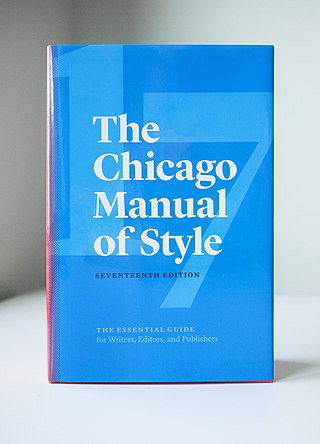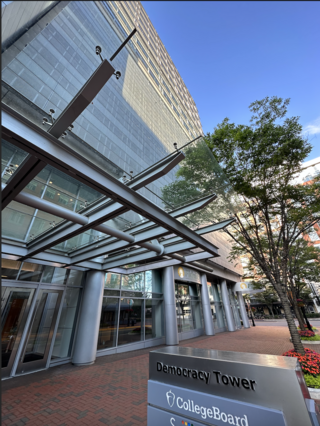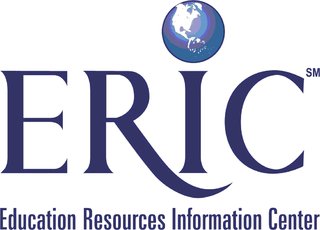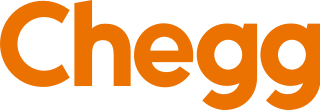
The Chicago Manual of Style is a style guide for American English published since 1906 by the University of Chicago Press. Its 17 editions have prescribed writing and citation styles widely used in publishing.

This page is a glossary of library and information science.

Questia was an online commercial digital repository of books and articles that had an academic orientation, with a particular emphasis on books and journal articles in the humanities and social sciences. All the text in all the Questia books and articles were available to subscribers; the site also included integrated research tools. It was founded in 1998 and ceased operations in December 2020.
Blended learning or hybrid learning, also known as technology-mediated instruction, web-enhanced instruction, or mixed-mode instruction, is an approach to education that combines online educational materials and opportunities for interaction online with physical place-based classroom methods.

The College Board is an American not-for-profit organization that was formed in December 1899 as the College Entrance Examination Board (CEEB) to expand access to higher education. While the College Board is not an association of colleges, it runs a membership association of institutions, including over 6,000 schools, colleges, universities, and other educational organizations.

A memorandum, also known as a briefing note, is a written message that is typically used in a professional setting. Commonly abbreviated memo, these messages are usually brief and are designed to be easily and quickly understood. Memos can thus communicate important information efficiently in order to make dynamic and effective changes.

Writing centers provide students with assistance on their papers, projects, reports, multi-modal documents, web pages, and other writerly needs across disciplines. Although writing center staff are often referred to as Tutors, writing centers are primarily places for collaboration in which writers and tutors work together to help writers achieve their goals. Typical services include help with the purpose, structure, function of writing, and are geared toward writers of various levels and fields of study. The goal is to help a writer learn to address the various exigences that they may encounter with the realization that no writing is decontextualized—it always addresses a specific audience. Writing centers may offer one-on-one scheduled tutoring appointments, group tutoring, and writing workshops. Services may also include drop-in hours. Writing tutors do not assign grades to students' writing assignments.

The Education Resources Information Center (ERIC) is an online digital library of education research and information. ERIC is sponsored by the Institute of Education Sciences of the United States Department of Education.
A thesis statement usually appears in the introductory paragraph of a paper. It offers a concise summary of the main point or claim of the essay, research paper, etc. It is usually expressed in one sentence, and the statement may be reiterated elsewhere. It contains the topic and the controlling idea.

A writing process describes a sequence of physical and mental actions that people take as they produce any kind of text. These actions nearly universally involve tools for physical or digital inscription: e.g., chisels, pencils, brushes, chalk, dyes, keyboards, touchscreens, etc.; these tools all have particular affordances that shape writers' processes. Writing processes are highly individuated and task-specific; they often involve other kinds of activities that are not usually thought of as writing per se.
A transition or linking word is a word or phrase that shows the relationship between paragraphs or sections of a text or speech. Transitions provide greater cohesion by making it more explicit or signaling how ideas relate to one another. Transitions are, in fact, "bridges" that "carry a reader from section to section". Transitions guide a reader/listener through steps of logic, increments of time, or through physical space. Transitions "connect words and ideas so that [...] readers don't have to do the mental work for [themselves]."
Self access language learning centers are educational facilities designed for student learning that is at least partially, if not fully self-directed. Students have access to resources ranging from photocopied exercises with answer keys to computer software for language learning. These centers are an outgrowth of a style of learning that can go by several names: learner-centered approach, learner autonomy or self-directed learning. These centers exist primarily in Asia, Europe and North America. Use of such facilities and the pedagogical theory they are based upon has its advantages and disadvantages. Proper use can result in a feeling of empowerment and better learning outcomes, but getting to the point where students and teachers can exploit them effectively can be problematic. For this reason, the structure of established self access centers varies from completely student-directed work with classroom immersion to programs that provide primarily tutor or instructor guidance for student work•
A style guide is a set of standards for the writing, formatting, and design of documents. A book-length style guide is often called a style manual or a manual of style. A short style guide, typically ranging from several to several dozen pages, is often called a style sheet. The standards documented in a style guide are applicable either for general use, or prescribed use for an individual publication, particular organization, or specific field.

nanoHUB.org is a science and engineering gateway comprising community-contributed resources and geared toward education, professional networking, and interactive simulation tools for nanotechnology. Funded by the United States National Science Foundation (NSF), it is a product of the Network for Computational Nanotechnology (NCN). NCN supports research efforts in nanoelectronics; nanomaterials; nanoelectromechanical systems (NEMS); nanofluidics; nanomedicine, nanobiology; and nanophotonics.
Universal instructional design (UID) or universal design for instruction (UDI) is an educational framework for applying universal design principles to learning environments with a goal toward greater accessibility for all students, including students with disabilities. UDI involves considering the potential needs of all learners when designing and delivering instruction by identifying and eliminating unnecessary barriers to teaching and learning while maintaining academic rigor. UDI is thus proactive and benefits all students, in contrast to providing accommodations for a specific student.

IUPUI University Library is the university library of Indiana University–Purdue University Indianapolis. IUPUI is an urban campus of Indiana University and Purdue University in Indianapolis, Indiana, United States. Indiana University is the managing partner.

Chegg, Inc., is an American education technology company based in Santa Clara, California. It provides homework help, digital and physical textbook rentals, textbooks, online tutoring, and other student services.
A pathfinder is a bibliography created to help begin research in a particular topic or subject area.. Pathfinders produced by the Library of Congress are known as "tracer bullets". What is special about a pathfinder is that it only refers to the information in a specific location, i.e. the shelves of a local library.

The Digital Writing and Research Lab (DWRL) is a research lab at The University of Texas at Austin, United States, dedicated to the identification and promotion of twenty-first-century literacies. These literacies range from navigating online newsfeeds and participating in social networking sites to composing multimedia texts that require producing, sampling, and/or remixing media content.

Pius XII Memorial Library is an academic library located on the Saint Louis University Frost Campus. Named after Pope Pius XII and built in 1959, it occupies 215,000 square feet and houses over 1.3 million volumes, including more than 30,000 rare books. It is the home of the Knights of Columbus Vatican Film Library.












